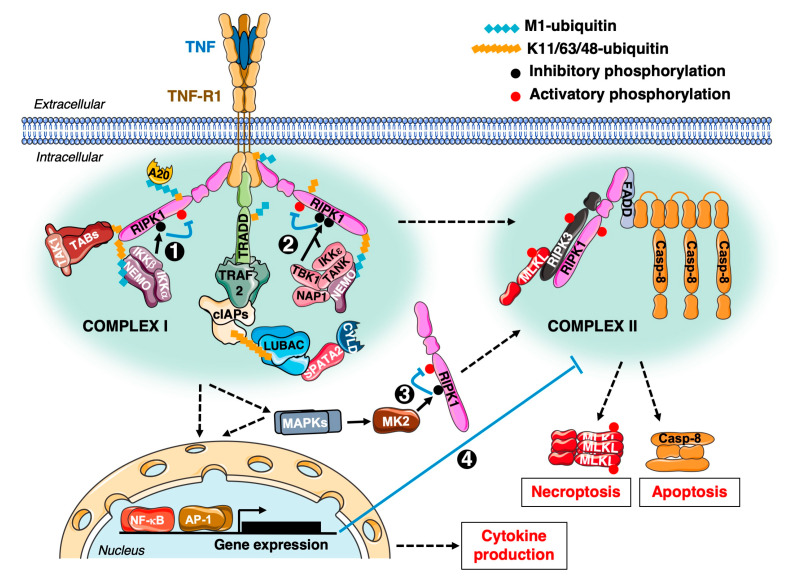Figure 1.
Tumor Necrosis Factor (TNF)/TNF-Receptor 1 (TNFR1)-mediated signalling and cell death checkpoints. Following binding of TNF to TNFR1, two complexes can be assembled: the TNFR1-associated Complex I (gene-activation) and a TNFR1-devoid Complex II (cell death induction) [30]. Complex I formation starts with the recruitment of TNFR1-Associated Death Domain protein (TRADD) and Receptor-Interacting serine/threonine Kinase 1 (RIPK1) to the Death Domain (DD) of TNFR1. TRADD further recruits TNFR-Associated Factor 2 (TRAF2) and cellular Inhibitor of Apoptosis Protein (cIAP)1/2. cIAP1/2 poly-ubiquitinate (ubiquitin linked through K11, K48 or K63) several components of Complex I. A recent report indicates that cIAP1, through K48 ubiquitination of RIPK1, promotes the degradation of the latter, thus limiting induction of cell death [52]. cIAP1/2-formed chains also recruit the Linear UBiquitin chain Assembly Complex (LUBAC), which further modifies several components with M1-linked ubiquitin, stabilizing Complex I. The absence of cIAPs and/or LUBAC results in reduced ubiquitination in, and stability of, Complex I and promotes the formation of Complex II. In complex I, cIAPs- and LUBAC-formed chains recruit the TGF-Beta Activated Kinase 1 (TAK1)/TAK1-Binding Proteins (TAB) complex and several Nuclear Factor-κB (NF-κB) Essential Modulator (NEMO)-containing complexes. The TAB/TAK complex activates Mitogen-Activated Protein Kinase (MAPK) pathways and allows for the activation of the NF-κB pathway by NEMO/Inhibitor of NF-κB Kinase α (IKKα)/IKKβ. IKKα/β, IKKε and TANK-Binding Kinase 1 (TBK1) directly phosphorylate RIPK1 [32,33,53,54] and thereby inhibit its autoactivation (checkpoints #1 and #2). This impedes RIPK1 detachment from Complex I and thus Complex II formation. A similar function is fulfilled by the p38 MAPK target MK2 [55,56,57] in the cytosol (checkpoint # 3). Downstream TNF-target genes include deubiquitinases (like CYLD and A20), pro-inflammatory cytokines, as well as proteins like cellular FLICE-Like Inhibitory Protein (cFLIP) which inhibit cell death initiation (cf part 1.3) at the level of complex II (checkpoint # 4) [58]. Whilst not represented here, some ubiquitinated RIPK1 and RIPK3 have also been detected in Complex II.

